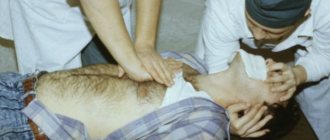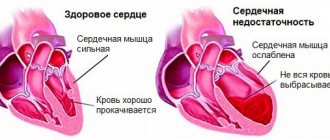The term cardiomyopathy (CM) is a collective name for a variety of myocardial diseases associated with disruption of its structure and function, not associated with arterial hypertension, circulatory disorders and valve diseases.
Most often, cardiomyopathy causes abnormal thickening of the heart muscle (hypertrophic cardiomyopathy) or enlargement of the heart chambers (dilated cardiomyopathy) due to genetic mutations or other causes.
1
Ultrasound of the heart for cardiomyopathy
2 Holter for cardiomyopathy
3 Diagnosis of cardiomyopathy
Classifications of cardiomyopathies
Classification of cardiomyopathies by origin
Based on their origin, they distinguish between primary (myocardial diseases of unknown origin) and secondary cardiomyopathy (the cause of myocardial damage is known or is associated with diseases of other organs).
Causes of primary cardiomyopathy:
- Genetic disorders;
- viral infections (Coxsackie, etc.);
- replacement of the heart muscle with connective or fatty tissue.
Causes of secondary cardiomyopathy:
- endocrine disorders (thyrotoxicosis, diabetes mellitus);
- intoxication (toxic, alcoholic, etc.);
- stress (Takotsubo cardiomyopathy).
Classification of cardiomyopathy according to clinical signs (main forms):
Dilated cardiomyopathy is the most severe and common. With this disease, cardiomegaly occurs - a significant increase in myocardial cavities. As a result, the heart loses its ability to fully pump blood. Dilated cardiomyopathy inevitably leads to the development of heart failure.
Peripartum (postpartum) cardiomyopathy is one of the types of dilated cardiomyopathy. Paradoxically, the development of heart failure in a woman and its characteristic symptoms is practically the main sign of the peripartum form. Other common options include alcohol.
Hypertrophic cardiomyopathy (HCM) is one of the main causes of sudden death in young, physically active people (athletes, military personnel). This cardiomyopathy is associated with thickening of the myocardium (cardiac muscle hypertrophy). The increase in wall thickness outpaces the development of blood vessels and, as a result, the blood supply to the heart muscle is disrupted, and the filling of the ventricles with blood also suffers.
HCM is more common in men.
Obstructive cardiomyopathy (subaortic subvalvular stenosis) is a type of hypertrophic cardiomyopathy in which blood flow into the aorta from the left ventricle is limited by a locally thickened interventricular septum.
Restrictive cardiomyopathy is a rare pathology in which the elastic properties of the heart walls deteriorate. The myocardium loses its ability to stretch and relax, which impairs its ability to fill with blood. The result is stagnation of blood in the veins and a lack of it in the arteries. The probable cause of this is abnormal proliferation of connective tissue.
Arrhythmogenic right ventricular cardiomyopathy (Fontan disease) - accompanied by life-threatening arrhythmias.
Arrhythmogenic CMP can cause ventricular arrhythmia in children and young adults with apparently normal hearts, as well as in older patients. The outcome of this disease is often sudden death, especially at a young age.
Takotsubo cardiomyopathy (broken heart syndrome) is a very rare disease in which a sudden, transient decrease in myocardial contractility develops. The shape of the left ventricle, due to pathological expansion, is externally similar to takotsubo - an octopus trap in Japan (it was in this country that this syndrome was discovered and described).
Takotsubo CMP is a cause of acute heart failure. It is more often detected in postmenopausal women and develops against the background of severe psycho-emotional shock. On the ECG it can masquerade as myocardial infarction.
1 Tests for cardiomyopathies
2 Diagnosis of cardiomyopathy
3 ECG for cardiomyopathies
A little history
Alcohol addiction and smoking are factors that increase the risk of developing takotsubo cardiomyopathy.
This heart disease was first described in 1991 by a group of Japanese scientists - Dr. H. Sato and his co-authors. It was they who gave it the name “takotsubo cardiomyopathy”, since the shape of the pathologically altered left ventricle in this disease resembled the device used by Japanese fishermen for catching octopuses - tako-tsubo. It was this symptom that made it possible to distinguish the syndrome in question from myocardial infarction. With this form of cardiomyopathy, the left ventricle becomes similar to tako-tsubo and during systole its apex does not contract, and its basal sections simultaneously contract excessively.
Takotsubo cardiomyopathy became widely known in 2006 thanks to a discussion of this topic at the European Congress of Cardiology held in Barcelona. Since then, scientists have begun to pay more attention to studying the mechanisms of its development. So far, specialists have not been able to fully study these aspects of the disease.
Symptoms of cardiomyopathy
Unfortunately, cardiomyopathy can occur for a long time without any symptoms, and then manifest itself with symptoms common to many cardiac diseases:
- shortness of breath with minor physical effort, walking;
- arrhythmias;
- pain in the heart area;
- constant loss of strength;
- dizziness;
- fainting states.
Often, cardiomyopathy can be suspected only when the disease is already in the stage of decompensation and all the symptoms of heart failure are present:
- shortness of breath even at rest;
- presence of swelling in the legs;
- ascites (accumulation of fluid in the abdominal cavity), enlarged liver, etc.;
- atrial fibrillation and other types of arrhythmias;
- cough that gets worse when lying down;
- attacks of suffocation;
- pulmonary edema.
1 Ultrasound of the heart for cardiopathy
2 ECGs for cardiomyopathies
3 Blood tests for cardiomyopathy
Hans Selye's theory of adaptation to stress
What is stress? This is a set of normal reactions of the body that occur in response to the action of unfavorable factors. War, famine, epidemic, car accident, marriage, birth of a child - all this can become stressful.
The regulation of metabolism, physiological reactions, and behavior is carried out by a chain of hypothalamus, pituitary gland and adrenal glands. Corticotropic hormone of the hypothalamus stimulates the production of adrenocorticotropic hormone of the pituitary gland, which in turn triggers the secretion of cortisol.
Cortisol is a steroid hormone. It is synthesized in the adrenal cortex. Cortisol inhibits the breakdown of glycogen in muscles, activates it in the liver, and takes part in the development of the body's response to stress. How does he work? This hormone stimulates the sympathetic nervous system, giving impetus to any activity.
The concentration of cortisol in the blood changes throughout the day: it is maximum in the morning, when you need to get up and start doing something, and gradually falls during the day. In the evening, the level of the hormone in the blood is low, a person can relax and fall asleep. If he is busy with something important and interesting, then the adrenal glands secrete more cortisol than during routine activities.
What happens under stress? Cortisol levels increase. The hormone tells the body: “fight or flight.” The pulse quickens, blood pressure rises, muscles tense - the person is preparing for immediate decisive action.
This mechanism of adaptation to stress was discovered back in 1936. The author of the theory, biochemist Hans Selye described in detail how the body reacts to any strong stimulus, and introduced the concepts of eustress and distress. In the first case, the body is mobilized to complete the task, the person feels cheerful, active, and productive. And when the situation returns to normal, cortisol levels decrease. A person can “exhale and relax.”
Distress is chronic stress in which cortisol concentrations remain high. A person does not have time to recover and spends all the body’s resources on maintaining combat readiness. Everyday problems do not require “putting out fires and stopping horses in a gallop,” but they constantly keep you at a “low start,” preventing you from relaxing or reacting with your body to relieve tension. Cortisol levels are still high, and the circadian rhythms of its secretion are disrupted. So a person begins to sleep worse at night, body weight increases, blood pressure rises, and the ratio of cholesterol fractions changes.
Selye's triad, which describes this condition, includes 3 groups of symptoms:
- stomach ulcer;
- hypertrophy of the adrenal cortex
- atrophy of the thymus gland (thymus).
“If stress is excessive, it can lead to hypertension, asthma, irritable bowel syndrome,” says Ernesto Shiffrin, a professor in the Faculty of Medicine at McGill University, Montreal.
Diagnosis of cardiomyopathy
Diagnosis of CMP should be trusted only to an experienced specialist, since the clinical picture for various pathologies has similar signs.
First, the doctor collects anamnesis and examines the patient (pays attention to skin color, clarifies the presence of edema, measures heart rate and blood pressure, listens to the heart and lungs with a stethoscope).
Next, laboratory and instrumental studies are prescribed:
- blood tests (clinical, biochemical, hormonal status, lipid profile, etc.);
- electrocardiography (ECG);
- Holter monitoring ECG;
- echocardiography (ultrasound of the heart);
- radiography;
- coronary angiography;
- MRI, CT scan of the heart.
Stressors: Holmes and Ray model
“What will happen to him! Look how he holds up!” - this can be said about any unfamiliar person, and then you are surprised to find out that he is trying his best and has already suffered 2 heart attacks. Based on the time of action, psychogenic factors of CVD are divided into mental trauma and psychotraumatic situations. Injuries occur suddenly, a person is at the mercy of emotions and often does not have time to adapt (acute stress). Psychotraumatic situations exist for a long time, sometimes for years. At some stage, a person can adapt to them, but over time, compensatory mechanisms are exhausted. The disease develops.
How can you assess the strength of the negative influence and the body’s resource? According to the importance of the operating factor, life situations are assigned different numbers of points. In 1970, American psychiatrists T. Holmes and R. Ray analyzed people's reactions to significant events, ranked them and compiled a scale of stressors. The list includes not only obvious disasters, but also a large number of “ordinary” events and situations. The ten most important situations are listed below in descending order:
- death of a spouse or other closest person;
- divorce of spouses;
- separation of spouses (in marriage);
- imprisonment;
- death of one close family member;
- illness (injury);
- marriage;
- dismissal;
- reconciliation of spouses;
- termination of work upon retirement.
Fewer points are “given” for changing jobs, vacations, pregnancy, fines for minor offenses, and changing habits. In the Holmes and Ray scale there are only 43 event points that can pull the rug out from under your feet.
To assess the resource and likelihood of developing a nervous or psychosomatic disorder, the authors of the theory recommended noting the events that a person experienced during the year and summing up the points. A high score on the Holmes and Ray scale indicates that the subject has exhausted his resources and needs immediate help.







